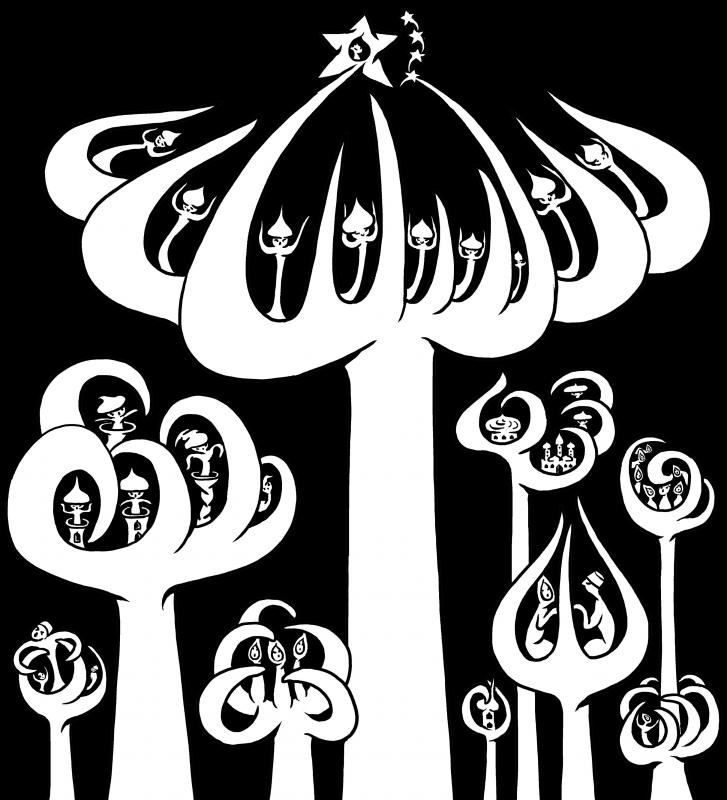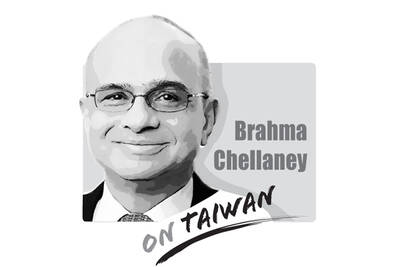On Thursday, the Uighur Tribunal delivered its damning judgement on the human rights abuses allegedly committed by the Chinese state in Xinjiang.
Over the past months the London-based people’s tribunal has heard testimony from international academics, as well as survivors of Chinese detention and “re-education camps.”
While the ruling has no legal standing, the aim is to highlight the treatment of Uighurs, Kazakhs and other Turkic Muslims in northwest China.

Illustration: Mountain People
Rachel Harris, a British ethnomusicologist and Uighur specialist, has described the state’s strategy as an attempt “to hollow out a whole culture and terrorize a whole people.”
Much has been written about the destruction of Uighur heritage: of the mosques and shrines, old city centers and traditional burial grounds. In order to understand what intangible heritage is being lost — what is being quite literally silenced — amid that bulldozing, I interviewed 10 specialists, including both Uighurs in exile and international academics with extensive experience on the ground.
In Muslim soundscapes the world over, the Adhan is the most salient of notes. Calls to prayer, though, have long been absent from urban Uighur life and now, even private devotion has reportedly been muted. Through a policy called “becoming family,” government officials are sent to stay in Uighur homes so as to root out anything deemed illegal (owning Uighur-language books, wearing traditional clothing).
Academics and pop culture figures have been disappeared en masse, among the estimated 1.5 million people detained in “re-education” camps, with children as young as one separated from parents and put in Mandarin-language state orphanages. Schools have been banned from teaching Uighur and no Uighur-language books have reportedly been published in China since 2017.
“People used to bury their books, but now they’re afraid to even do that,” US photographer Lisa Ross said.
In a bid to cut off an indigenous culture at the root, the Uighurs language, sound and music are being excised from the public and private spheres.
When Darren Byler, an anthropologist from Colorado, lived in Urumchi in the early 2010s, student house parties — which were held most weekends — always involved everyone making music together. Friends would bring instruments. People were always singing.
“Everyone is a poet,” Byler said. “People think poetically.”
As a Turkic language, Uighur is agglutinative, he said, so they would often have fun adding rhyming suffixes to the ends of their words. This verbal dexterity defines ancient storytelling forms like the epic dastan — spoken tales — that pilgrims would hear at festivals in the Taklamakan desert. It also birthed a vibrant local hip-hop scene in Urumchi that Byler came to know.
Now, all gatherings — prayer in public, mazar (shrine) festivals, traditional meshrep parties, hip-hop cyphers, even soccer matches — have been outlawed.
Destroying a built structure makes visible the dismantlement of more abstract cultural ones. The mazar, which are dotted throughout the desert as well as in towns and cities, are a case in point. Before they were razed, these shrines were closed. This resulted in the rural community structures and ancient cultural practices that activated them being shut down, too.
Mazar festivals would be held every Thursday at certain periods of the year: throughout the mulberry season at Imam Asim shrine, or during grape season at Kok Marim shrine. Starting in the early 2000s, Ross documented the mazar extensively. She photographed mountains of handmade prayer flags and devotional objects affixed to wooden poles that day pilgrims — in their tens of thousands — would bring each year.
A Uighur academic, who wished to remain anonymous, described what it felt like to be there. At Imam Asim, there were tandoori pots the size of small rooms, in which a gaggle of men with shovels would stir a stew called sheeylang. Pilgrims would add in whatever they could (a sheep they had brought to slaughter on site; a single grain of rice).
And the sound?
“It’s like a wedding and a funeral happening at the same time,” the academic said.
There would be epic dastan sessions, stories reminding pilgrims of why they came and where they come from.
There would be dancing, drumming, chanting, weeping, praying.
“It is something you won’t hear anywhere else,” the academic said.
When Harris and Rahile Dawut — a Uighur folklore expert who disappeared four years ago and whose imprisonment has since been confirmed — visited the largest and oldest shrine, Ordam Padishah, in 1995, they wrote that state opposition to the shrines lay arguably in the sphere of aesthetics — the sights and sounds — rather than in response to any political threat.
The site was closed to the public in 1997 and satellite imagery now shows it has been entirely razed. Imam Asim, too.
The Australian Strategic Policy Institute puts the number of mosques, mazar and cemeteries in Xinjiang that have been damaged or destroyed since 2017 at up to 80 percent.
Elsewhere, a re-engineered version of living Uighur culture has been instituted. This process is best illustrated by what has happened to meshrep.
In this uniquely Uighur festive tradition, music and storytelling are used to transmit cultural or moral knowledge, but when China sought for meshrep to be included on UNESCO’s intangible cultural heritage list in 2009, Harris, who was acting as official examiner, pushed back.
“I thought the only way for meshrep to be sustained would be by folkloric presentation,” she said.
UNESCO nonetheless granted China the heritage status it wanted and China promptly banned grassroots gatherings. Villages now have state-sanctioned meshrep centers with murals featuring slogans — “Everyone let’s dance,” “Welcome to our meshrep” — that drive home the notion of what is “healthy” (acceptable) meshrep and what is not. Religious lyrics are rewritten as revolutionary patriotism. Uighurs are forced to attend.
Performers also have to take part in exoticized song-and-dance spectacles that cater to the growing national tourism industry.
“You can see them on YouTube, and I mean, they are amazing,” Harris said.
However, these shows turn the Uighur people into “empty vessels who sing and dance and smile for tourists, but have no rights to develop their own culture or religion,” she said.
I spoke to Mukaddas Mijit, a Uighur academic, filmmaker and dancer who was born in Urumchi in the 1980s. She first left Xinjiang for Paris in the early 2000s to pursue classical piano studies, but when she realized no one in France knew anything about where she came from, she pivoted to ethnomusicology and delved into her family’s history. She discovered that her great-grandfather had been a Sufi master.
“I came to my heritage through my studies,” Mijit said. “It became my life.”
Last year, Mijit and Harris organized an online event billed as the first transcontinental Uighur concert. Under the banner “Longing for Home,” musicians from across the globe played from the classical muqam repertoire for two hours. It brought Mijit to tears.
“It is really beautiful to hear this music,” she said. “Beautiful song, beautiful poetry. This is us, this is our voice, this is our culture.”
Exile has always been a potent musical metaphor, but in the context of the Uighur people’s plight, it is not imagery. It is an emergency.

As strategic tensions escalate across the vast Indo-Pacific region, Taiwan has emerged as more than a potential flashpoint. It is the fulcrum upon which the credibility of the evolving American-led strategy of integrated deterrence now rests. How the US and regional powers like Japan respond to Taiwan’s defense, and how credible the deterrent against Chinese aggression proves to be, will profoundly shape the Indo-Pacific security architecture for years to come. A successful defense of Taiwan through strengthened deterrence in the Indo-Pacific would enhance the credibility of the US-led alliance system and underpin America’s global preeminence, while a failure of integrated deterrence would
US President Donald Trump created some consternation in Taiwan last week when he told a news conference that a successful trade deal with China would help with “unification.” Although the People’s Republic of China has never ruled Taiwan, Trump’s language struck a raw nerve in Taiwan given his open siding with Russian President Vladimir Putin’s aggression seeking to “reunify” Ukraine and Russia. On earlier occasions, Trump has criticized Taiwan for “stealing” the US’ chip industry and for relying too much on the US for defense, ominously presaging a weakening of US support for Taiwan. However, further examination of Trump’s remarks in
It is being said every second day: The ongoing recall campaign in Taiwan — where citizens are trying to collect enough signatures to trigger re-elections for a number of Chinese Nationalist Party (KMT) legislators — is orchestrated by the Democratic Progressive Party (DPP), or even President William Lai (賴清德) himself. The KMT makes the claim, and foreign media and analysts repeat it. However, they never show any proof — because there is not any. It is alarming how easily academics, journalists and experts toss around claims that amount to accusing a democratic government of conspiracy — without a shred of evidence. These
China on May 23, 1951, imposed the so-called “17-Point Agreement” to formally annex Tibet. In March, China in its 18th White Paper misleadingly said it laid “firm foundations for the region’s human rights cause.” The agreement is invalid in international law, because it was signed under threat. Ngapo Ngawang Jigme, head of the Tibetan delegation sent to China for peace negotiations, was not authorized to sign the agreement on behalf of the Tibetan government and the delegation was made to sign it under duress. After seven decades, Tibet remains intact and there is global outpouring of sympathy for Tibetans. This realization